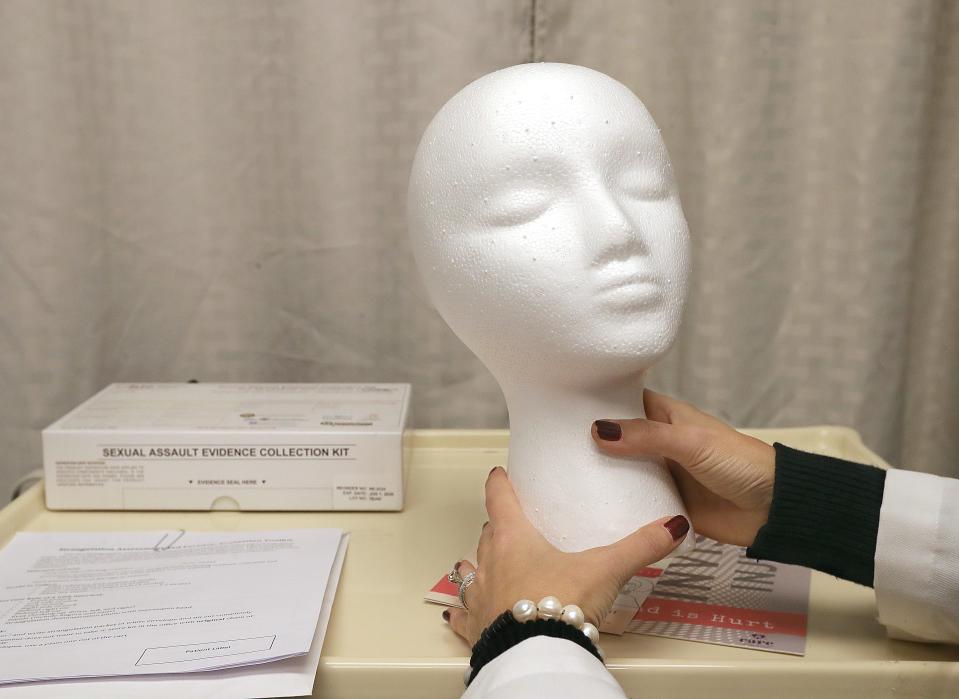Ohio strengthens strangulation charge, becoming last state to make it a felony
As her estranged husband held her against the wall, squeezing her neck with both hands, a Barberton woman kept thinking, “I have to get free.”
She tried to grab his head and face as he stared at her with an odd, toothy smile.

He then grabbed her arms with one hand, keeping his other hand on her neck.
“I just wanted desperately to breathe,” the 46-year-old woman recalled.
He finally let go, and she gasped for air. As soon as she could scream, she yelled for her roommate to call 911.
Police took her estranged husband into custody, charging him with domestic violence and strangulation in the May incident.
The man, who isn’t being named to protect the victim’s identity for safety reasons, was among the first people in Summit County charged under a law effective in April that made strangulation a felony.
Victim advocates and forensic nurses lobbied for years to toughen charges related to strangulations, which typically involve domestic violence and too often are followed by murders. Ohio was the last state to make strangulation a felony.
Strangulation injuries can linger long after visible bruises have faded, leaving victims at risk of a stroke and mental health issues like post-traumatic stress disorder and, in severe cases, traumatic brain injuries.
Twenty-two percent of the people killed by their partners in Ohio between June 2022 and July 2023 died from strangulation or traumatic brain injuries, according to the Ohio Domestic Violence Network (ODVN).
“Strangulation is not okay,” said Rachel Ramirez, the director of health and disability programs for ODVN. “Strangulation is not something we’re willing to tolerate. If you do it, there will be consequences.”
The Barberton woman was sore and bruised after the altercation with her husband, which ruptured one of her breast implants.
The 56-year-old man, who told police he grabbed his wife by the neck after she tried to hit him, took a plea deal in November. He received two years of probation, with the conditions including $12,702 in restitution for his wife’s ruptured implant.
Strangulation punishable by up to 8 years in prison
Ohio’s strangulation law prohibits a person from causing serious harm or creating a “substantial risk” of harm through strangulation or suffocation.
It defines strangulation or suffocation as impeding “the normal breathing or circulation of the blood by applying pressure to the throat or neck or by covering the nose and mouth.”
Depending on the severity of harm and the relationship between the person charged and the victim, strangulation can be a second- to fifth-degree felony. A second-degree felony carries a penalty of up to eight years in prison, while a fifth-degree felony can result in up to 12 months in prison but doesn’t require incarceration.
Lily Holderbaum, a forensic nurse and the head of the PATH, or Providing Access to Healing, program at Cleveland Clinic Akron General, said strangulation is dangerous because it involves “intentional deadly force.”
“That patient could have died within minutes,” she said.

Holderbaum said her program, which assists victims of domestic violence, sexual assault and elder abuse, sees about 1,000 patients a year from Summit and surrounding counties, and about 25% have been strangled.
When strangulation victims are examined, Holderbaum said hospital staff take photographs of their injuries, swab for DNA, get details about the incident and have them demonstrate how they were strangled with a mannequin.
Holderbaum said strangulation victims are at risk of a blood clot or stroke that might not happen until a week or month later.
She also said victims of strangulation aren’t always seen in the emergency department and may end up seeking treatment in another department, such as physical or occupational therapy. The hospital plans to offer training on strangulation in March to departments outside of the ER.
“There isn’t enough of a discussion of the injuries that can happen with strangulation,” she said.
Strangulation law ‘reflects the seriousness of the crime,’ prosecutor says
Elliot Kolkovich, the community outreach prosecutor for the Summit County Prosecutor’s office, said strangulations often happen in volatile domestic situations that could also involve multiple forms of injury, such as punching, slapping and throwing a person onto the ground or against something.
Prior to the strangulation law, Kolkovich said a person could have been charged under the domestic violence, assault or felonious assault statutes, depending on how seriously the victim was injured. He said strangulation victims, though, might not immediately have visible injuries beyond something like petechiae, or ruptured blood vessels, in the eyes.
Now that strangulation is at least a fifth-degree felony, Kolkovich said, it has stiffer penalties than domestic violence, which is a first-degree misdemeanor for a first offense with a minor injury.
“It reflects the seriousness of the crime,” Kolkovich said. “Some of the domestic violence incidents involve hitting and punching. When you have a strangulation, you could be close to taking a person’s life.”
Implementation of Ohio’s new law varies
Victim advocates say some communities are charging a lot of people under the new strangulation law, while others have been slower to implement it.
“There have been some great success stories and frustrations,” Ramirez said. “Law enforcement has a lot on their hands. I do think we need to give them a little bit of time and grace.”
Ramirez pointed to Columbus as one of the cities that has been the most proactive in responding to the law. The city used an $800,000 federal grant to create a multi-agency strangulation task force and to train officers about strangulation.
Columbus took this step after seeing a 200% increase in homicides involving domestic violence in 2023.
More: Columbus domestic violence homicides up 200% in 2023. How one family is finding hope
Though few strangulations cases have gone to trial so far across Ohio, a Canton man was sentenced to four years in prison in December after being convicted in a jury trial of choking, punching and slapping a woman.
Devion Williams, 31, was convicted of two counts each of strangulation and domestic violence for incidents that happened in Canton in April, just a few weeks after the strangulation law took effect.
Police say Williams choked the victim and shoved a sock down her throat to prevent her from breathing, then punched and slapped her.

Williams’ attorney argued for probation, but prosecutors said he couldn’t be trusted in the community.
Stark County Common Pleas Judge Natalie Haupt said she thought prison time was warranted.
“I think this case demonstrates the very reason that strangulation is now a felony in Ohio,” Haupt said.
Williams, whose strangulation case is the only one to go to trial so far in Stark County, plans to appeal.
How many strangulation cases have been filed in Portage County?
Portage County Prosecutor Victor Vigluicci said there were 29 strangulation cases filed in 2023 after the law went into effect in April.
"We're using the law quite a bit," said Vigluicci. "As soon as it came out, back in April, we did an education to all the [police] departments and sent them language, the text of it, and encouraged them to utilize it in a lot of the domestic violence situations where we saw it arising in the past and really didn't have anything to charge but the basic violence."
According to a report compiled by the prosecutor's office, strangulation was the sole charge in 19 of those indictments. Of the remaining 10 cases, five included felonious assault while domestic violence and aggravated burglary were each included in four cases. Kidnapping appears in three cases and several other charges, including violation of a protection order and robbery, appear in single cases.
Only one case involved a defendant female: a teen accused of trying to strangle her father.
Vigluicci said factors such as whether the defendant is a repeat offender or the victim is pregnant can bump up the seriousness of the charge. Evidence of strangulation can include testimony of the victim and sometimes a witness, as well as loss of consciousness and marks on the throat, though such physical evidence is not necessarily required.
"I think [the law has] long been needed and Ohio has been behind a lot of other states in enacting such legislation," he said. "Strangulation often occurs, but the evidence of it is often not obvious until you get to the point of somebody losing consciousness or having ligature marks and strangulation could occur long before unconsciousness or ligature marks are present."
As of Wednesday , there have been 10 strangulation cases so far in 2024, said Vigluicci. In one indictment, filed Feb. 1, a South Euclid man, 30, is charged with third-degree felony strangulation and misdemeanor domestic violence and endangering children stemming from a Jan. 28 incident involving a 3-year-old boy at a Streetsboro apartment.
According to court records, the man is accused of holding the boy in the air by the throat, causing him to gasp, and slamming the boy against a wall hard enough to break the drywall.
Vigluicci said child victims are unusual in strangulation cases.
"Usually it's a spouse, significant other, dating relationships," he said.
Barberton man gets probation for strangulation incident involving his wife
The Barberton woman who was attacked by her husband said she didn’t know about the felony strangulation law until her estranged husband was charged with it.
“It is a good thing,” she said. “If it was a misdemeanor, if he reoffended again, it would just be the same.
“I don’t want him to ever hurt another woman,” she continued.
The two were separated at the time of the May 13 incident and are now going through a divorce.
Her husband told police he got into an argument with her and she threw a bowl at him, which didn’t hit him. He said she tried to escort him out of the house and, when he stopped, she attempted to hit him a few times. He said he grabbed her by the neck so she would stop, according to an incident report.
The victim’s roommate told police she heard the couple arguing and, when she came downstairs, saw the husband holding his wife by the neck and then taking her to the ground. She said her friend asked her to call 911 and she did, according to the report.
The woman had red marks on her neck and arms, while her husband had no injuries, according to the report.
The man pleaded guilty in Summit County Common Pleas Court in November to strangulation, a fourth-degree felony, and domestic violence, a first-degree misdemeanor.
John Alexander, the man’s attorney, said his client agreed to the plea after prosecutors said he could be charged with felonious assault because of his wife’s ruptured breast implant. He said his client claims he didn’t intend to strangle his wife but was trying to restrain her.
Judge Kathryn Michael sentenced the man to two years of probation, with a reserved prison sentence of 18 months possible if he violates the terms of his probation. She ordered that he complete a 26-week Conflict Resolutions Program, pay restitution to his wife, and have no contact with her except for during court proceedings pertaining to their divorce.
The woman said she’s still having nightmares in which she sees her husband’s grinning face. She recently started counseling, which she thinks she should have done sooner.
“I basically took my healing and hid it and let it go and shouldn’t have,” she said. “I could be in a better place in my head right now.”
She urged other strangulation victims to access the help available to them as soon as they can.
“There are programs to help you,” she said. “And, you’re not alone. That’s the most important thing.”
Record-Courier reporter Jeff Saunders contributed to this report. Stephanie Warsmith can be reached at swarsmith@thebeaconjournal.com, 330-996-3705 and on Twitter: @swarsamithabj.
This article originally appeared on Akron Beacon Journal: Ohio strengthens penalties for strangulation charge

